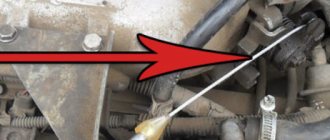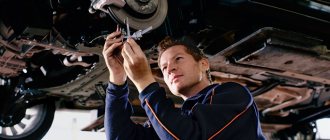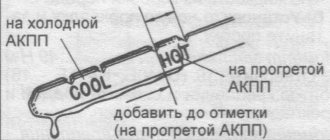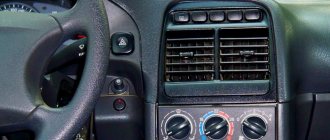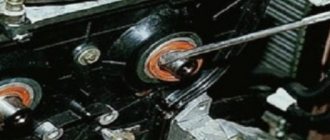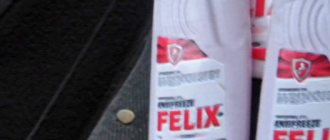There is vibration during acceleration: the main causes of the problem
Author: Dmitry Sapko
There can be a huge number of possible problems with a car, and a specific breakdown does not always give specific signs of its presence. Drivers often complain about body shaking when accelerating or at a certain speed. There can be quite a lot of problems that determine this indicator. If your car has vibration during acceleration, you should look at all possible breakdowns and immediately replace the failed components.
It is not always possible to tell by the nature of the vibration where exactly the problem lies. On different cars, only the steering column can vibrate, putting it in the driver’s hands, but the entire body can shake. It all depends on the design, nature and degree of damage to the components and assemblies that need to be replaced. Let's look at the main causes of vibration during overclocking.
Content
Description of the front suspension design of Lada Kalina 1117 2004 - 2013
Front suspension:
1 — cover; 2 — ball joint; 3 - retaining ring; 4 — hub bearing nut; 5 — protective cap; 6 — hub; 7 — hub bearing; 8 — steering knuckle; 9 — front wheel brake disc; 10 — brake mechanism shield; 11 - nut; 12 — eccentric (adjusting) bolt; 13 — rotary lever; 14 — front suspension spring; 15 — shock absorber rod; 16 — upper spring cup; 17 — upper support of the shock absorber strut; 18 — shock absorber rod nut; 19 — bearing of the upper support of the shock absorber strut; 20 — spring gasket; 21 — front suspension compression buffer; 22 — protective casing; 23 — telescopic stand; 24 — front wheel drive shaft; 25 — bracket for mounting the anti-roll bar cushion; 26 — front suspension stretch; 27 — anti-roll bar; 28 — stabilizer bar; 29 — front suspension lever.
The front suspension is independent with telescopic hydraulic shock absorbers, coil conical springs, lower wishbones with braces and a stabilizer bar.
The basis of the suspension is a telescopic hydraulic shock absorber strut. Its lower part is connected to the steering knuckle with two bolts. The top bolt that goes through the hole in the strut bracket has an eccentric collar and an eccentric washer. By turning this bolt, the camber angle of the front wheel is adjusted. The telescopic strut is equipped with a helical conical spring, a polyurethane foam compression stroke buffer, as well as an upper strut support assembly with a bearing.
The upper support is secured with three self-locking nuts to the body mudguard cup. Its design differs significantly from the design of the supports used on VAZ-2108-2110 vehicles. Now, instead of a pressed-in thrust bearing, a steel bushing is installed, vulcanized to the rubber mass of the support, which eliminates backlash and extraneous sounds.
The thrust ball bearing used in automobiles has a larger diameter and a different design and is located between the upper support and the spring. Under the weight of the front of the car, the bearing is in a compressed position, which eliminates all gaps and knocks. The contact area of the balls with the raceways has increased significantly, and consequently, the durability of the bearing has increased.
In the new design, when the wheels turn, the strut housing rotates along with the spring. In this case, the shock absorber rod remains motionless and the connection between the rod and the shock absorber guide bushing wears less. A telescopic hydraulic shock absorber is installed in the strut housing.
The lower part of the steering knuckle is connected to the lower suspension arm through a ball joint. The support is attached to the steering knuckle with two bolts (the holes in the steering knuckle are not through). When unscrewing these bolts, be careful: with significant force they often break, so before disassembling, tap their heads in the axial direction.
Braking and traction forces when the car is moving are perceived by longitudinal braces connected through silent blocks to the lower arms and brackets installed on the lower cross member of the radiator frame. At the connection points (at both ends of the brace) washers are installed to adjust the longitudinal inclination of the wheel turning axis.
The steering knuckle is equipped with a double-row angular contact ball bearing of a closed type, which is secured in the knuckle with two retaining rings. The wheel hub is installed in the inner rings of the bearing with interference fit. The bearing is tightened with a nut on the shank of the outer wheel drive joint housing. The bearing is not adjustable in operation. The wheel hub nuts are the same, with right-hand threads.
The anti-roll bar is a spring steel bar. In its middle part there is a bend above the pipe of the additional muffler of the exhaust gas system.
Both ends of the stabilizer bar are connected to the lower suspension arms through struts with rubber and rubber-metal hinges. The rod in its middle part is attached to the body with brackets through rubber pads.
We study wheels and chassis - the main cause of vibrations
The main indicator that the wheels or drives of these same wheels are to blame for your problems is shaking at a certain speed. Often these are body vibrations in the range of 80-100 kilometers per hour, but sometimes the shaking may not go away even after 60 km/h, so in any case you need to fully diagnose the chassis.
In this case, it is not necessary to go to a service station and carry out expensive diagnostic operations. It is enough to apply all your knowledge and study each chassis unit for possible breakdown. The most common problems in this case are the following:
- the wheel mounts are unscrewed, which causes vibration on one of the wheels;
- The brake disc is poorly fixed; at speed it begins to vibrate;
- the wheel drive shaft is bent - the body vibrates constantly, the vibration intensifies when accelerating;
- damaged CV joints - this is the most common problem that causes vibrations on the body;
- The wheel bearings are damaged, which causes shaking at any speed.
The most common problem in this manifestation is CV joints. To check their serviceability, just grab the shaft with your hand and try to turn it. If the shaft has play of more than a couple of millimeters, the CV joint must be replaced. Interestingly, body vibrations during vehicle acceleration can be caused by both external and internal CV joints.
You can also easily determine if there is a problem with this chassis mechanism by examining the anthers. If the rubber part of the boot ruptures, we can safely talk about problems with this mechanism. If water, dust and dirt get into the CV joint, the unit will not survive more than a few days.
21124, shakes when starting off
1200 km.
The last 300-400, when starting off smoothly, it began to shake if the revolutions were less than 2000. Moreover, after a run of 10 km, the shaking stopped, everything was fine. The clutch was Valeo, but for some reason they had a Turkish one. IMHO, either the flywheel is crooked, or the disk, or maybe the springs. but why everything goes away after 10 km is not clear to me. What do you advise? torture them under warranty? +1 it was the same thing and in general the first time they came I didn’t take a lot of money and in the end after rebuilding the gearbox there was nothing left for the flywheel and for a normal clutch
forced to install crafttech
After three months of nervous trips through traffic jams in a shaking car, I came to them and, having changed the flywheel, installed a new set of clutches, and the old one looked great, I didn’t argue since it was useless (the old flywheel), but at the same time the old flywheel looked invigorating, to summarize I’ll say that it looks like a left-wing guys have been trading for a long time, whether they themselves know about it or not, I don’t know.
Dan, it looks like he has no connection with the motor, this motor is choking, it’s a bit poor, something xx
maybe masturbation maybe sasamba
Ronych, you should be included in the fact, not in the sense of being a fact.
I mean, we buy unscorched Valeo couplings from Ronalda.
Lenya asked me once if I didn’t have a clutch, to which I replied that no, and I didn’t plan to go for it, but he told me where I could buy a known good clutch (from the same warehouse, I know the stores and clients).
But the author did exactly what he did.
Denis knows that with 10 clutches there was a problem at one time - a defective bearing, the dealer replaced it for free. I haven't heard any complaints lately. I have never seen the “made in Turkey” mark.
I can’t afford to keep a supply of clutches, because I don’t have the skills to replace them in an hour and a half or two :)))
yyy, yes, my friend, you need to change the logic, something is wrong with the engineer, even the cold one is lucky.
There are actually several options - crooked sensors including the mass air flow sensor, dirty and dead masturbation with rxx or crooked program
some kind of garbage, because it looks more like an air leak from somewhere.
Did you check the rail pressure? are the forces alive?
O! what is the consumption? Somehow, when the air filter was clogged and filled, the flow rate was within 11 - after replacing the filter it went to the standard 13
